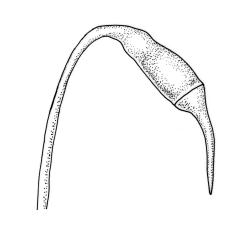The taxonomic and nomenclatural histories of this genus and its type species are exceedingly obscure, and beyond the scope of this Flora. In summary, the generic name Rhaphidorrhynchium is attributed by Fleischer (1923, p. 1245) to the preprint (not seen) of Bescherelle’s (1875) paper dealing with the mosses of Île St Paul and Île Amsterdam in the southern Indian Ocean, wherein Rhaphidorrhynchium is a nom. nud. Hence, the most informative bibliographic citation is Rhaphidorrhynchium Besch. ex M.Fleisch., Musci Fl. Buitenzorg 4: 1245 (1923). The type of the genus is given by Fleischer (1923, p. 1246) as Rhaphidorrhynchium aurescens Besch. However, Ramsay et al. (2004) asserted that R. aurescens was invalid until subsequently validated by Jaeger and cited the species as R. aurescens (Besch. ex A.Jaeger) M.Fleisch. The Tropicos database (accessed on 3 Nov. 2015) gives the basionym of the species name as Rhaphidostegium aurescens A.Jaeger (1880).
Generic descriptions, in German, are provided by both Fleischer (1923, p. 1245) and Brotherus (1925, p. 425). It is unclear how much of Fleischer’s generic description is based on the species he accepted from Java, rather than from the generitype.
The decision of Ramsay et al. (2004) to recognise the genus Rhaphidorrhynchium is followed here as a convenience. In the early 20th century the genus received currency due to its use by Fleischer (1923, p. 1245) and Brotherus (1925). More recently, Rhaphidorrhynchium seems to have had little use outside the Australasian literature. It is included in the classification used for the Flora of Australia (McCarthy 2006, end-papers) and in the key to Australian moss genera by Buck et al. (2002, p. 30). The genus Rhaphidorrhynchium is not included in the classification of Goffinet et al. (2009).
According to Ramsay et al. (2004) Rhaphidorrhynchium "has a Gondwanan distribution with a number of species scattered throughout Australasia, South America, and Africa, extending northward in Asia reaching Malesia and India."
No generic description is supplied here, in part because no material of the type species has been available.
| Category | Number |
|---|---|
| Indigenous (Non-endemic) | 1 |
| Total | 1 |




